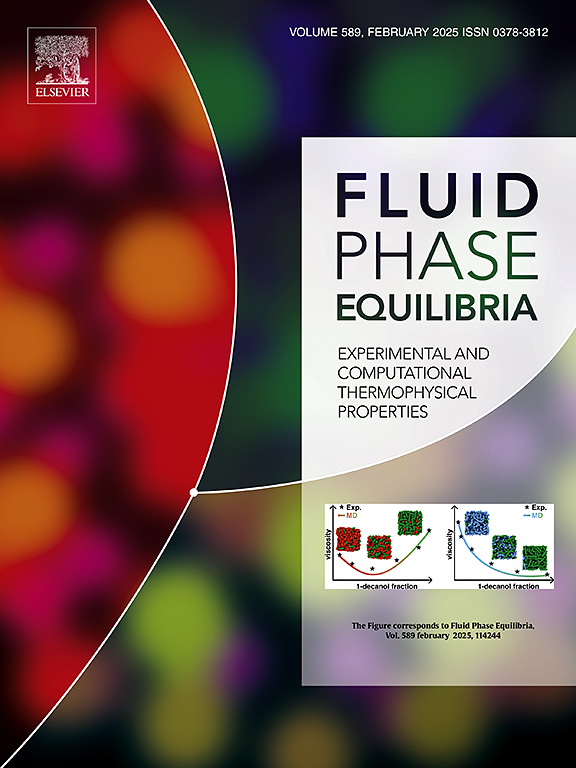Artificial neural network-based estimation of interaction parameters between carbon dioxide and organic solvents using the Peng–Robinson equation of state with the van der Waals one-fluid mixing rule and quantum chemical data
IF 2.7
3区 工程技术
Q3 CHEMISTRY, PHYSICAL
引用次数: 0
Abstract
The Peng–Robinson (PR)-van der Waals (vdW) model, which combines the PR equation of state with the vdW one-fluid mixing rule, is often used to estimate the physical properties of CO2/organic solvent mixtures. Calculating these properties using the PR-vdW model requires interaction parameters kij; however, reports on these parameters are limited. This article introduces an artificial neural network (ANN) to predict kij between CO2 and organic solvents, using pure-component parameters and molecular information as inputs. The molecular information is obtained through the general-purpose quantum chemical calculation software Gaussian. In addition, the ANN is optimized by varying the transfer function, number of neurons, and number of hidden layers. The optimized ANN employs a tanh function as the transfer function for the hidden layers, with two hidden layers containing 40 and 10 neurons. This model effectively predicts kij for a wide range of substances and temperature conditions. Furthermore, SHapley Additive exPlanations analysis of the optimized ANN reveals a significant contribution from the quadrupole moment, likely due to quadrupole interactions between CO2 and the organic solvents. These results support the estimation of the physical properties of CO2/organic solvent mixtures.

基于van der Waals单流体混合规则的Peng-Robinson状态方程和量子化学数据的二氧化碳与有机溶剂相互作用参数的人工神经网络估计
Peng-Robinson (PR)-van der Waals (vdW)模型是将PR状态方程与vdW单流体混合规律相结合的模型,常用于估算CO2/有机溶剂混合物的物理性质。使用PR-vdW模型计算这些属性需要交互参数kij;然而,关于这些参数的报告是有限的。本文介绍了一种以纯组分参数和分子信息为输入的人工神经网络(ANN)来预测CO2与有机溶剂之间的kij。分子信息通过通用量子化学计算软件Gaussian获得。此外,通过改变传递函数、神经元数量和隐藏层数量来优化人工神经网络。优化后的ANN采用tanh函数作为隐藏层的传递函数,隐藏层分别包含40个和10个神经元。该模型有效地预测了各种物质和温度条件下的kij。此外,优化后的人工神经网络的SHapley加性解释分析揭示了四极矩的显著贡献,可能是由于CO2和有机溶剂之间的四极相互作用。这些结果支持了对CO2/有机溶剂混合物物理性质的估计。
本文章由计算机程序翻译,如有差异,请以英文原文为准。
求助全文
约1分钟内获得全文
求助全文
来源期刊

Fluid Phase Equilibria
工程技术-工程:化工
CiteScore
5.30
自引率
15.40%
发文量
223
审稿时长
53 days
期刊介绍:
Fluid Phase Equilibria publishes high-quality papers dealing with experimental, theoretical, and applied research related to equilibrium and transport properties of fluids, solids, and interfaces. Subjects of interest include physical/phase and chemical equilibria; equilibrium and nonequilibrium thermophysical properties; fundamental thermodynamic relations; and stability. The systems central to the journal include pure substances and mixtures of organic and inorganic materials, including polymers, biochemicals, and surfactants with sufficient characterization of composition and purity for the results to be reproduced. Alloys are of interest only when thermodynamic studies are included, purely material studies will not be considered. In all cases, authors are expected to provide physical or chemical interpretations of the results.
Experimental research can include measurements under all conditions of temperature, pressure, and composition, including critical and supercritical. Measurements are to be associated with systems and conditions of fundamental or applied interest, and may not be only a collection of routine data, such as physical property or solubility measurements at limited pressures and temperatures close to ambient, or surfactant studies focussed strictly on micellisation or micelle structure. Papers reporting common data must be accompanied by new physical insights and/or contemporary or new theory or techniques.
 求助内容:
求助内容: 应助结果提醒方式:
应助结果提醒方式:


